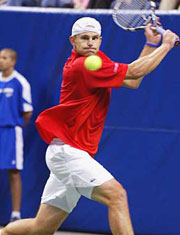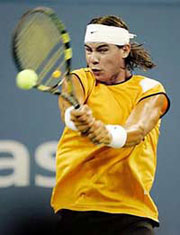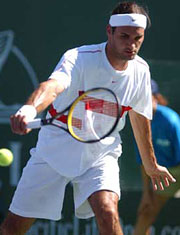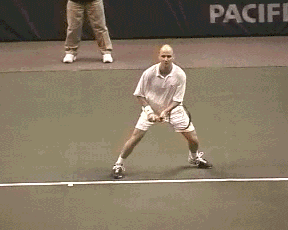|
TennisOne Lessons Controlled Aggression Novak Djokovic, Andre Agassi, Jimmy Connors – and you? Jim McLennan Novak Djokovic stunned the tennis world at the ATP Masters Series in Montreal, beating in succession Andy Roddick, Rafael Nadal, and then Roger Federer to capture the title and put the men on notice – there is a new kid on the block and “Nole” is the real deal. In the final, broadcaster Darren Cahill (Andre Agassi’s former coach) drew parallels between Novak’s style of play and Andre Agassi's. Using the term “controlled aggression” Cahill described a good match for Agassi as one with few errors and actually few winners, but with the high forced and unforced error rate on the other side of the net, a result of the consistently aggressive play of Agassi, and now of Djokovic. Controlled, in that the intent of play was not to strike outright winners, but rather to pound the ball from on or inside the baseline, more or less throwing “body blows” rather than “knock out punches.” Further, recalling Agassi patrolling the baseline, as well as Jimmy Connors before him, Novak appears willing to keep the ball in play, trading heavy grounds, but not at all in a defensive manner.
Though generalizations can often get one in trouble – let me gamble on the following three styles of play – Big Defense, Winners from Any Position, and Controlled Aggression. Big Defense, where players camp well behind the baseline, rally interminably, and hit the ball impossibly hard but rarely from attacking positions. This powerful game of attrition, favored by grinders is less about winners or offense, and more about fitness concentration and securing a narrow edge over the opponent. Matches are long, volleys are rare, and in this instance I long for the “old days.”
Winners from any position describes a style of play favored by the shot makers including John McEnroe and now Roger Federer, who could and now can make nearly any shot from any position. And within this style of play often there are an astounding number of winners by match end, including the tremendous Wimbledon performance of Richard Gasquet over Andy Roddick with as many as 80 winners. These types of players are capable of incredible wins but equally vexing losses, perhaps no better typified than by the play of James Blake. Finally controlled aggression describes a style of consistent, high percentage, positioned on or inside the baseline, offensive take the ball on the rise type of game. Where Agassi, Connors before him, and now Djokovic simply trade big heavy consistent ground strokes, nothing flashy, just a series of unending body blows. Interestingly, in the Rogers Cup final, Federer was often uncharacteristically late, and seemed to be dominated (at least within the tie breakers) by an opponent with heavier shots and better length. So what are the cues, and clues to this style of play? How might you incorporate elements of controlled aggression within your own game? Reader, it will all be about court position, body weight against the ball, confidence in the backhand rather than favoring the run around forehand, and the ability to end the point off either wing. First and foremost patrol the baseline. Take the ball on the rise, not necessarily with approach shots, but simply do not give ground. Not so much taking the racquet back early, but rather an inclination to take the ball early. The moment one gives ground, the opponent can sense a weakness, a chink in the armor. nterestingly, Agassi was Federer’s most dangerous rival (before Nadal came along) because he denied Federer the usual openings afforded by players who either ran around their backhands or those who camped well behind the baseline. As a practical matter, one can practice this on the ball machine or with a practice partner, provided one rarely if ever backs up, takes pace off, or floats the return. Another variation on this drill occurs when you stay precisely on the baseline, moving side to side as needed but never forward or back. The trick is to master the timing of the half volley, and develop comfort playing from this area of the court. Agassi pounded the ball from the baseline. Connors pounded the ball from the baseline. Novak pounds the ball. Now it is your turn. Body Weight Against the Ball
In spite of open stance, jumping ground strokes, in most instances the best players are grounded during the hit. We marvel at the shot making from impossible running positions, but in the main when not pressed to the corners the best players stay on the ground and place their body weight against the ball. When patrolling the baseline, and practicing heavy shots, use your body weight as much as possible. You will feel the difference when on perfect balance. Tom Stow called it “swinging slow to hit hard.” The drill involves "holding your finish" for a two count beat. Certainly this cannot be done in a vigorous rally but can be practiced if a friend feeds the balls or if you are using a ball machine. As you count One … Two, note your balance, and specifically whether the back leg has swung loose and slightly forward such that you could be tapping the back toe. In this manner one feels whether the hips have totally contributed to the hit, or whether one is muscling the ball. Confidence in the Backhand Jimbo never ran around the backhand. And in spite of the run around forehand favored by Jim Courier and now Roddick, Blake and so many others, this move exposes tremendous open court, and requires often riskier shot making to make up for the awkward court positioning. At an early stage of Agassi’s career, he often scurried around his backhand, this in spite of a deadly two fisted backhand. As he matured, and his results and Grand Slam titles followed this late stage maturity, Agassi was content to play backhands from the backhand corner, driving the ball with minimum footwork to the ball as well as minimum recovery footwork. When Roddick and Agassi played at the 2002 Siebel Open in San Jose, Roddick was generally pinned in the backhand corner. When trading backhand to backhand, Agassi always had the upper hand. When Roddick ran around his backhand the predicament only worsened for then he was hopelessly out of position for the remainder of the rally.
In the post match interview he said he felt like he had been playing in the “12’s (and unders). Controlled aggression requires a backhand every bit as deadly as the forehand. Check your grips and your mentality on this one, if the ground strokes are equally heavy off both wings the opponent is denied an easy strategy. But to develop confidence in the backhand, one must simply go back to the basics (and you may consult the library on the series “First Things First). Whether using a one or two handed backhand (and on this you can surely model Rosewall or Agassi from within our library) the keys include: Turn to the side as soon as you recognize the ball coming to your backhand. Relax the arms, too often players take the racquet back early with tension and straight elbow(s). Wait for the ball on the back foot. If moving to the ball, arrive yet again on this back foot. Begin the forward swing with a slight weight shift, followed by a turn into the ball, and finish with good extension of the arm(s) through the ball at contact. Finally, Novak can and does knock the ball off for winners off both wings, and from all parts of the court. Controlled aggression in this instance means the ability to finish the point, but not in the way that one relies on winners to win the point. Rather, and this is important, the ability and willingness to keep the ball in play, but if and when the opportunity arises, the ability to end the point there and then. Too often, and I believe you will notice, many of the modern players (especially those who practice the art of Big Defense) are unwilling or unable to thread the needle at just the right moment. Not in a risk taking manner, but rather from a common sense approach to tennis. So to practice your version of this drill on the ball machine, place cones in the corners of the back court and in the corners of the service box. Then, practice threading the needle, with precise down the line winners, sharply angled cross courts (to the cones in the corners of the service box) and heavy and deep cross court drives (to the cones in the corners of the back court). With repeated practice you will quickly find out which of these shots comes most easily to you, and which will require additional attention. Keep the ball in play. Drive the ball heavily off both wings. Hold your ground on the baseline. Thread the needle when the opportunity arises. Connors. Agassi. Djokovic. This will be an interesting summer. Your comments are welcome. Let us know what you think about Jim McLennan's article by emailing us here at TennisOne.
|
|||||||||||||






